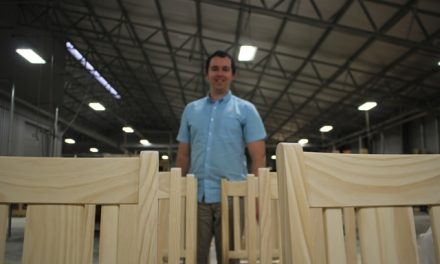On a quiet lake shore an hour and a half north of Oslo, the world’s tallest timber building is quickly taking shape.
Nearly 1000 years after Norway’s famous stave churches soared skywards, the Scandinavian nation remains a powerhouse of timber construction and is erecting the world’s tallest timber building. Situated in Brumunddal, a settlement in the Ringsaker district about an hour and a half north of Oslo, Mjøstårnet is a mixed-use tower on the shores of Lake Mjøsa, incorporating apartments, a hotel, offices and restaurants.
Due to be structurally completed in June of this year, Mjøstårnet will stand 81m above the ground, with 18 storeys and a combined floor area around 11,300m2. Yet the construction process involves no external scaffolding, relying instead on a sophisticated glulam-based system, all provided by local suppliers and using sustainable, local resources.
The project’s client, Arthur Buchardt, a leading Norwegian investor, grew up in the area. “Ringsaker is the municipality in the world that produces the most timber-based products for the building industry,” he says. “[It also has] the greatest expertise in building large, complex timber buildings.
“The raw materials for Mjøstårnet are sourced close by. The timber logs are sawn locally and processed into wonderful timber building materials using local manufacture. And the expertise is here.”
Materials
The structural timber components are all supplied by Moelven Limtre AS and include glulam columns, beams and diagonals, CLT elevator shafts and stairs, and Trä8 floor slabs for the tower building and swimming hall included in the broader project. Untreated Norway spruce is the main species used for structural timber parts.
The Trä8 concept was developed by Moelven Töreboda in Sweden, part of the Scandinavia-wide Moelven group. These floor slabs are built on a deck system with glulam girders and flanges from Moelven. An LVL top plate from Metsä Wood is glued to the girders, while insulating Rockwool® is kept in place by steel brackets that help add to the structure’s well-rated fire resistance. The slabs are fitted with a diffusion open sheathing on top. Most elements have a 50mm concrete screed on top.
The maximum span of the Trä8 floor slabs used in Mjøstårnet is 7.5m, but the system can reach spans of nearly 10m, while using less in materials than comparable CLT decks. The slabs are light and quick to assemble, but still easily meet both acoustic requirements and fire safety requirements. The carbon footprint is particularly low, estimated at about 65kg CO2/m2.
Powder coated S355 steel is used in connections combined with acid-proof steel dowels. The wooden cladding is supplied by Woodify and has fire retardant properties. A full discussion of the building’s elements is available in PDF form at moelven.com/Products-and-services/Mjostarnet/Paper-about-the-construction-of-Mjostarnet/
Construction
Mjøstårnet’s footprint is about 17 x 37m2. A concrete slab on the ground floor is supported by piles driven to the bedrock below. The main load bearing structure consists of large scale glulam trusses along the facades as well as internal columns and beams. The trusses handle the global forces in horizontal and vertical directions and give the building its necessary stiffness. CLT walls are used for the secondary load bearing of three elevators and two staircases. The CLT does not contribute to the building’s horizontal stability.
The glulam structure is assembled on the ground next to the building, before being hoisted up and in. Then the floor slabs are hoisted into place. The construction has been broken into stages of four-storey sets. After the first two were completed in November, Moelven has taken a short break to allow another company to install the external facade and walls, before Moelven proceeds with assembly upwards.
Rune Abrahamsen CEO of Moelven Limtre describes the process: “Assembly is done without external scaffolding. This means working with cranes and supplementing with lifts. Contractor HENT has only one large crane, and the use of it must be shared between the various disciplines working at the building site. At the moment, assembly of the wood structures has priority. This is a huge crane, and is very costly to use. Proper use of the crane is therefore essential both for progress and cost control on the project.
“Taking a short break from the building will allow Ringsaker Vegg- og Takelementer AS to install walls from the bottom up to the seventh floor. That will [make them weathertight and] mean that indoor work can start in these seven storeys when the walls are in place,” Abrahamsen says.
While floors 2 to 11 are prefabricated wooden decks based on Moelven’s Trä8 building system, floors 12 to 18 are 300mm concrete floors made as a composite of a prefabricated bottom part, which acts as formwork for a cast-in-place upper part. Replacing wood with concrete in the upper floors means the building will be heavier towards the top. This building is slender in its weak direction, so the extra mass is necessary to comply with comfort criteria
for apartments. The concrete decks also make it somewhat easier to deliver a high-standard acoustic performance in the upper level apartments.
All glulam elements are connected by use of slotted-in steel plates and dowels. These are high-capacity connections that are commonly used in bridges and large buildings. The structural timber is on the inside of the facade and glass elements. This protects the timber from rain and sun, increases durability and reduces ongoing maintenance needs. It also lets the glulam breathe freely on the inside.
All glulam surfaces have been painted with one layer of varnish. Visible surfaces will be painted with a top layer at a later stage. Endgrain of columns at the ground floor has been sealed with epoxy. Exposed endgrain of column tops and exposed sides of LVL are also protected. A moisture control plan has been developed to ensure correct handling of wood on site. This plan includes measuring and monitoring moisture content of specified parts of the structure.
Precision work
Building Mjøstårnet requires extreme accuracy in everything from the production of the glulam elements, the processing and transport, to hoisting and final assembly at the building site.
“Ordinarily [our] structures are trial assembled in a hall before being disassembled and transported to the building site,” Abrahamsen explains. “This is not the case here [due to the size of the building]. The structures are sent directly to the building site from processing for assembly. For this reason, there are extreme demands towards accuracy and quality assurance throughout the process. Things can’t be a millimetre off.”
He says that one glulam beam in Mjøstårnet has had to be removed and replaced. “There’s always a certain risk that this has to be done. Regardless, this assembly method is better both for us and the others involved in the project as it ensures a shorter construction time,” says Abrahamsen.
“We all have a responsibility to find new ways of thinking, and of actually doing,” say Buchardt. “It’s the first time in history that something like this has been constructed on this scale, and it’s also the first time in history that the materials and expertise have been sourced locally, and that’s part of our commitment to sustainable movements being put into practice.”
The success of the build to date is not lost on Buchardt. “[It has] required an unparalleled level of skill among those who calculate and construct, and it’s the interaction and cooperation between all these remarkable forces that make this project possible,” he says.
More than just celebrating local industry, Buchardt sees building in timber as an investment in the future. “Studies show that building with wood instead of concrete can reduce CO2 emissions by up to 30 per cent. Greenhouse gas emissions and rising temperatures are serious matters. Each and every one of us needs to become aware of what we do, what we consume and how we live. We each have to contribute in our own way.
“With this project I wanted to get across an important message,” Buchardt says. “To prove what is possible. And building with wood will contribute to a better environment. It’s sustainable. Building with wood is contributing to a better world to breathe in. A better climate for everyone.”
The building will officially open on 1 March, 2019, but the lessons it has to teach about tall timber constructions and what’s possible when industry starts innovating with traditional products and techniques are already making a difference. As Mjøstårnet shows, you can be local and also world-leading.
For more details, visit moelven.com/Products-and-services/Mjostarnet/
IMAGE: Mjøstårnet: its name means ‘tower of Lake Mjøså’.










